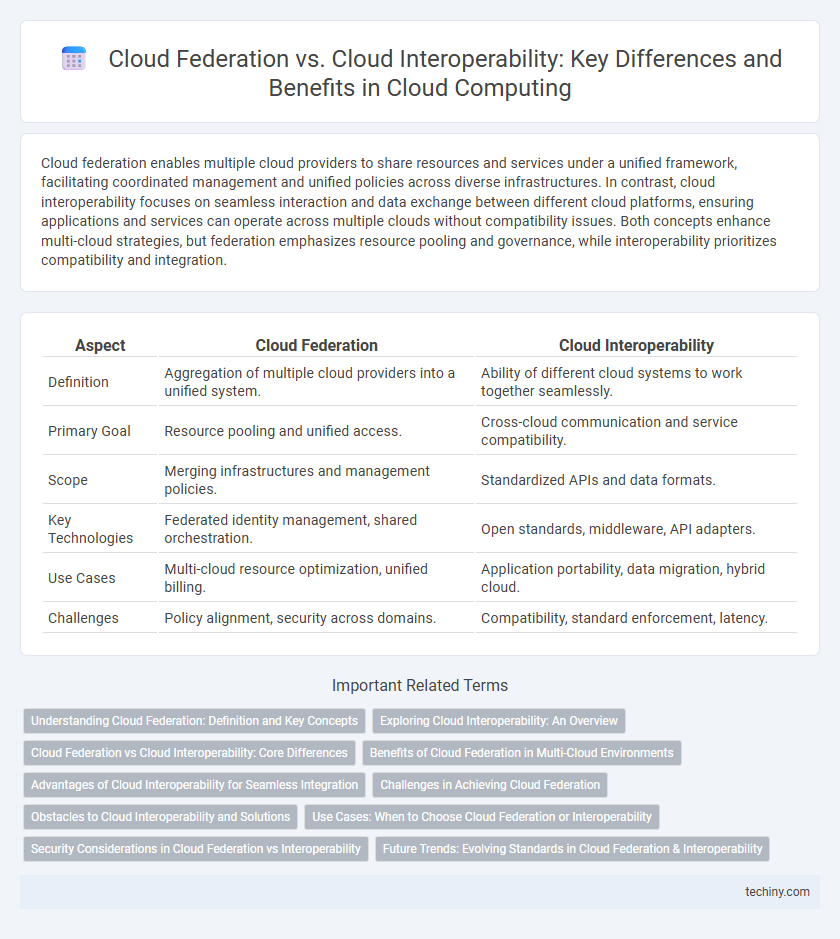Cloud federation enables multiple cloud providers to share resources and services under a unified framework, facilitating coordinated management and unified policies across diverse infrastructures. In contrast, cloud interoperability focuses on seamless interaction and data exchange between different cloud platforms, ensuring applications and services can operate across multiple clouds without compatibility issues. Both concepts enhance multi-cloud strategies, but federation emphasizes resource pooling and governance, while interoperability prioritizes compatibility and integration.
Table of Comparison
| Aspect | Cloud Federation | Cloud Interoperability |
|---|---|---|
| Definition | Aggregation of multiple cloud providers into a unified system. | Ability of different cloud systems to work together seamlessly. |
| Primary Goal | Resource pooling and unified access. | Cross-cloud communication and service compatibility. |
| Scope | Merging infrastructures and management policies. | Standardized APIs and data formats. |
| Key Technologies | Federated identity management, shared orchestration. | Open standards, middleware, API adapters. |
| Use Cases | Multi-cloud resource optimization, unified billing. | Application portability, data migration, hybrid cloud. |
| Challenges | Policy alignment, security across domains. | Compatibility, standard enforcement, latency. |
Understanding Cloud Federation: Definition and Key Concepts
Cloud Federation involves integrating multiple cloud service providers to create a unified, scalable infrastructure that enhances resource sharing and workload management across distributed environments. It enables organizations to maintain control over their individual clouds while benefiting from collaborative services, improving flexibility and redundancy. Key concepts include trust management, service-level agreement harmonization, and workload portability, which collectively ensure seamless operation and consistent policy enforcement across federated cloud networks.
Exploring Cloud Interoperability: An Overview
Cloud interoperability enables seamless integration and communication between diverse cloud platforms, allowing businesses to leverage multiple cloud services without vendor lock-in. It focuses on standardizing APIs, data formats, and protocols to ensure compatibility across public, private, and hybrid clouds. Effective cloud interoperability enhances flexibility, resource optimization, and workload portability in multi-cloud environments.
Cloud Federation vs Cloud Interoperability: Core Differences
Cloud Federation involves integrating multiple cloud services into a unified system to enable seamless resource sharing and management across distinct cloud environments. Cloud Interoperability focuses on ensuring different cloud platforms can communicate and work together by standardizing data formats, APIs, and protocols. While federation emphasizes collaborative resource pooling and joint governance, interoperability targets technical compatibility and data exchange between heterogeneous cloud systems.
Benefits of Cloud Federation in Multi-Cloud Environments
Cloud federation enables seamless resource sharing and workload distribution across multiple cloud providers, enhancing scalability and cost-efficiency in multi-cloud environments. It improves data sovereignty and compliance by allowing organizations to choose clouds based on geographic and regulatory requirements. Cloud federation also fosters resilience and failover capabilities, ensuring continuous service availability through coordinated cloud infrastructures.
Advantages of Cloud Interoperability for Seamless Integration
Cloud interoperability enables seamless integration between diverse cloud platforms by standardizing protocols and APIs, reducing vendor lock-in and enhancing flexibility for dynamic workload management. It facilitates unified data exchange and application portability, allowing organizations to optimize resource allocation across public, private, and hybrid clouds. Enhanced interoperability improves collaboration, accelerates digital transformation, and supports scalable, cost-efficient cloud architectures.
Challenges in Achieving Cloud Federation
Challenges in achieving cloud federation include ensuring seamless interoperability between heterogeneous cloud platforms while maintaining robust security and data privacy. Managing consistent policy enforcement, reliable resource allocation, and unified identity management across multiple providers complicates the integration process. Performance optimization and compliance with diverse regulatory standards further hinder the establishment of a cohesive federated cloud environment.
Obstacles to Cloud Interoperability and Solutions
Obstacles to cloud interoperability include heterogeneous cloud architectures, incompatible APIs, and data format disparities that hinder seamless integration across multiple cloud services. Solutions involve adopting standardized protocols, such as Open Cloud Computing Interface (OCCI) and Cloud Infrastructure Management Interface (CIMI), along with middleware platforms that facilitate unified resource management and data exchange. Leveraging containerization technologies like Kubernetes also enhances portability and operational consistency across diverse cloud environments.
Use Cases: When to Choose Cloud Federation or Interoperability
Cloud federation suits scenarios requiring seamless resource sharing and unified management across multiple cloud providers, ideal for large enterprises aiming to leverage diverse cloud services without vendor lock-in. Cloud interoperability is preferred when applications need to operate smoothly across different cloud platforms, ensuring consistent performance and data exchange without altering underlying infrastructures. Organizations focused on scalability, cost optimization, and disaster recovery often combine both approaches to maximize flexibility and resilience in multi-cloud environments.
Security Considerations in Cloud Federation vs Interoperability
Cloud federation requires robust security frameworks to manage trust and access control across multiple independent cloud providers, ensuring data confidentiality and compliance with diverse regulatory environments. In contrast, cloud interoperability emphasizes standardized security protocols and encryption methods to enable seamless and secure data exchange between cloud platforms. Both approaches must address identity management and threat detection, but federation security is more complex due to the distributed nature of governance and policy enforcement.
Future Trends: Evolving Standards in Cloud Federation & Interoperability
Future trends in cloud computing highlight evolving standards in cloud federation and interoperability aiming to enhance seamless data exchange and resource sharing across diverse cloud platforms. Emerging protocols such as Open Cloud Computing Interface (OCCI) and Cloud Infrastructure Management Interface (CIMI) push standardization forward, enabling improved multi-cloud orchestration and collaborative service delivery. These advancements accelerate hybrid cloud adoption and support dynamic workload migration by establishing unified APIs and governance frameworks.
Cloud Federation vs Cloud Interoperability Infographic

 techiny.com
techiny.com